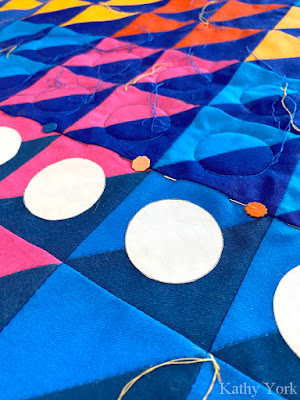No. 7
24.5" x 24.5"
Yet another one that did not photograph well on the day that I did the photography. Until then, I present to you, a portrait of No. 7 with Malin, our resident troll (by Thomas Dambo). Malin is here to remind us that we should share water and resources with the animals that live here with us. A perfect complement to my all blue quilt. And, an inspiration every time I go into my garden.
I have been making a lot of blue quilts, and thought maybe I should try a monochromatic one. Just the blues! I love the way I feel when I am around this quilt, but then again, I really do love the color blue. It is soothing to me and I feel content and happy. If a quilt can melt my stress away, and I assert that it can, this one does it for me.
Once I have all the blocks sewn and trimmed and up on the design wall...I can't help myself but to play with them in different ways to see what they would look like. It is the perfect time before they are all sewn together. This variation is a 9 block shuffle of the center blocks. I like it, but think it would be better with blocks that have more contrast.
The next one is a linear variation where I moved entire rows to the right or left.I really like this version too. It is interesting and has movement and rhythm.
Ultimately, I like the simplicity of the first version. And so begins the stitching of the blocks.
Next comes the basting. For many years I have done safety pin basting. And now, I can't remember why, I have transitioned to thread basting. I think it holds the layers together better....? or maybe it just works better for me?I have a leather thimble on one hand, and a grapefruit spoon in the other. I use a very long and strong needle and thread of a contrasting color. It goes relatively quickly for a small quilt.Next is the quilting. I had decided to use matchstick quilting for this one, and each column of blocks has a different thread color...though you absolutely cannot tell after all this quilting...I am not sure what I would have done differently, but after finishing, I did not think the quilting enhanced the quilt at all. Which is not typically what I want...I think the quilting should enhance the design, and this one didn't really do that for me.
It does making an interesting texture where the seams overlap at the corners though!
After quilting, this one needed blocking. Love the contrast of the quilt with the IKEA rug!
This one is a strong contender for the winner of the first 10 in this series. The winner will be made into a BIG quilt!



















































